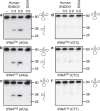Endonuclease V cleaves at inosines in RNA
- PMID: 23912683
- PMCID: PMC3741635
- DOI: 10.1038/ncomms3271
Endonuclease V cleaves at inosines in RNA
Abstract
Endonuclease V orthologues are highly conserved proteins found in all kingdoms of life. While the prokaryotic enzymes are DNA repair proteins for removal of deaminated adenosine (inosine) from the genome, no clear role for the eukaryotic counterparts has hitherto been described. Here we report that human endonuclease V (ENDOV) and also Escherichia coli endonuclease V are highly active ribonucleases specific for inosine in RNA. Inosines are normal residues in certain RNAs introduced by specific deaminases. Adenosine-to-inosine editing is essential for proper function of these transcripts and defects are linked to various human disease. Here we show that human ENDOV cleaves an RNA substrate containing inosine in a position corresponding to a biologically important site for deamination in the Gabra-3 transcript of the GABA(A) neurotransmitter. Further, human ENDOV specifically incises transfer RNAs with inosine in the wobble position. This previously unknown RNA incision activity may suggest a role for endonuclease V in normal RNA metabolism.
Figures




References
Publication types
MeSH terms
Substances
LinkOut - more resources
Full Text Sources
Other Literature Sources
Molecular Biology Databases

